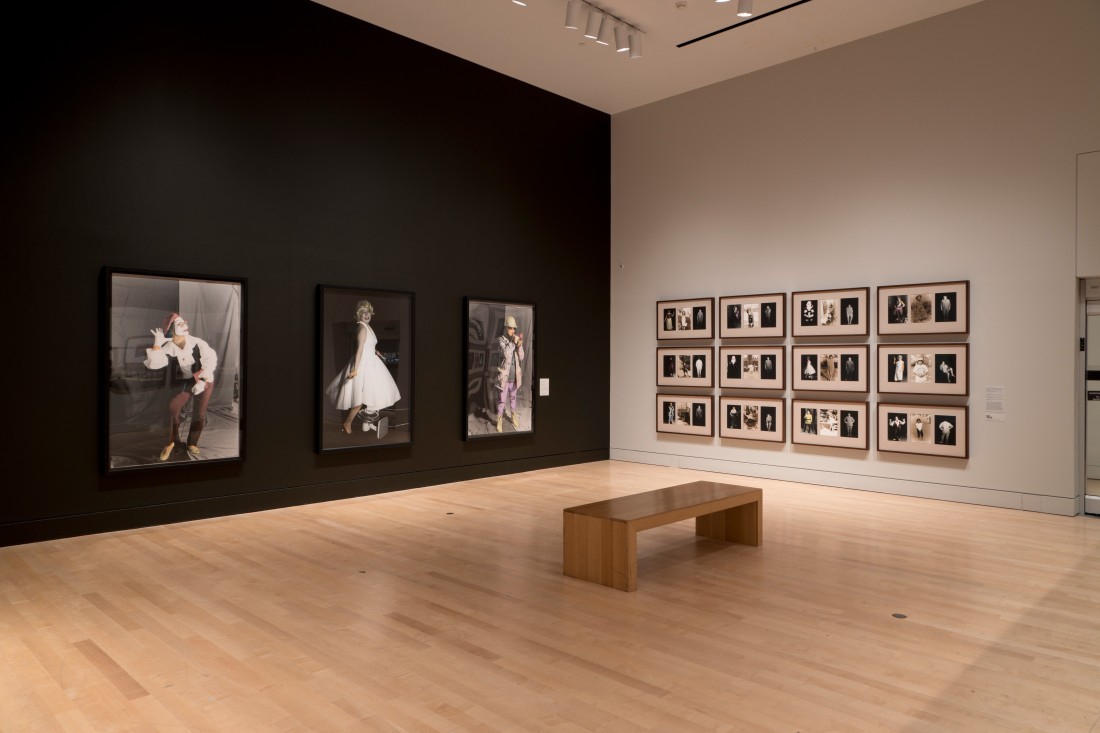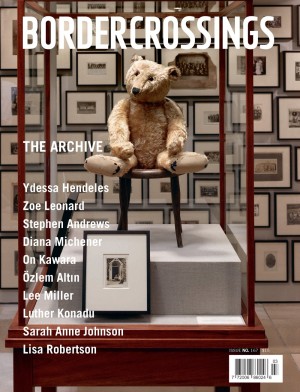Shelley Niro
“Shelley Niro: 500 Year Itch” is a sprawling, voluminous, four-decade retrospective of the multimedia work of Brantford, Ontario-based Mohawk artist Shelley Niro. Given this timeline, Niro’s career spans the breadth of identity politics’ practice in Canada. This ambitious yet cohesive exhibition, which toured to the Smithsonian’s National Museum of the American Indian late last year, before opening at the Art Gallery of Hamilton, is especially significant, given the scale and sheer range of styles and subjects. Included are film, painting, installation, video, sculpture and mixed media, making up 70 works, some of which are series.
Curators Melissa Bennett, Greg Hill and David Penney astutely divided the exhibition into four categories: Matriarchy, Past is Present, Actors, and Family Relations. Binding these divisions are Niro’s depictions of the family and the aspects of everyday life they concern. The women in Niro’s family, including her mother, daughter and sisters, are centrally featured in much of her work; men are rarely present. Niro’s practice mixes contemporary life with performance, pop culture and Indigenous history and mythology through a feminist lens, often with humour.

Shelley Niro, 500 Year Itch, 1992, gelatin silver print heightened with applied colour, mounted on Masonite, 186.3 × 125.3 × 5 centimetres. Collection of National Gallery of Canada, Ottawa. Gift of Victoria Henry, Ottawa, 2003. Courtesy Art Gallery of Hamilton, Hamilton.
The Rebel, 1982–1987, likely Niro’s best-known piece, depicts her mother, Chiquita, posing across the trunk of a car, hand placed behind her head, mimicking the faux-seductive poses of car ad models. The piece satirizes car ad sexism by substituting a middle-aged Indigenous woman for the youthful, often White models lounging on upmarket sports cars. Addressing ageism, sexism and racism in one now-iconic image, The Rebel aligns with the media-influenced photography of the ’80s Pictures Generation in appropriating mass media strategies (e.g., the work of Cindy Sherman and Laurie Simmons). However, Niro’s photography differs. Rather than mimicking media strategies, she critiques them by inserting her experience and identity in place of glamour.
General Idea (GI), active in Toronto when Niro was attending the Ontario College of Art (now Ontario College of Art and Design University), practised an initially similar strategy of queer ing mainstream media, filling what they called its “empty shell” with their content. Contrastingly, GI’s mock glam aimed to compete with media glam—for instance, with the Miss General Idea beauty contest, rather than counter to it. Niro’s approach is the antithesis of GI’s muse, the Warholian superstar; instead, The Rebel remains on the media’s margins, lampooning and politicizing rather than copying.
Similarly undermining popular culture is This Land is Mime Land, 1992, a hand-coloured silver print in which the artist, dressed as a mime, gestures toward an imaginary (or gallery) audience. The piece plays on the Canadian version of the Woody Guthrie song “This Land Is Your Land/This Land Is My Land.” The question arises over whom “my” refers to and whom it rightly should. Are settlers miming ownership? Additionally, as a performer, Niro mimics a form of White European culture, beret et al., and the photograph itself is a representation of a performance or a mime.

Installation view, “Shelley Niro: 500 Year Itch,” 2024, Art Gallery of Hamilton. Photo: Robert McNair. Courtesy Art Gallery of Hamilton.
This photograph came at a cultural crossroads in Canada—1992, a year marking the 500th anniversary of Christopher Columbus’s arrival in the Americas and closely following the 1990 Oka Crisis. This was an era of reckoning and questioning, leading to the first wave of identity politics, including an explosion of Indigenous art and a welcoming institutional response. Niro’s first solo exhibition was held at Toronto’s Mercer Union gallery in 1992.
Included in that exhibition was “In Her Lifetime,” 1991–2021, a series of six black and white digital prints. One depicts a woman posing by the water holding an umbrella with overlain text reading, “Native issues would never be resolved in her lifetime.” The next reads, “She would give herself a shake and realize Christmas was six months away the kids would be out of school soon,” followed by “and Friday was just a day away.” The photographs ironically consider the mundanity of daily life in a dominant culture underscored by a dark historical hegemony.
Like “In Her Lifetime,” The Shirt, 2003, reflects the “past is present” subtheme but differs by infusing pop culture, rather than daily life, with colonization. Created in collaboration with Veronica Passalacqua and Hulleah J Tsinhnahjinnie, it includes nine lightboxes with photos forming a narrative through t-shirt texts. One states, “Attempts were made to assimilate, colonize, and displace them.” The final concludes, “And all’s I get is this shirt.”
Such a mix between past and present runs through the work, but some pieces, notably those exploring matriarchy, centre on looking at the past for empowerment. Inspiring Niro is Sky Woman, a figure symbolic of the matriarchal “system of the Kanyen’kehà:ka peoples, part of the greater Haudenosaunee (Iroquois) Confederacy.” The Sky Woman is a creation story in which a pregnant woman fell through a hole in the sky to Turtle Island (Earth). Sky Woman and the daughter she was pregnant with became its first inhabitants.

Installation view, “Shelley Niro: 500 Year Itch,” 2024, Art Gallery of Hamilton. Photo: Robert McNair. Courtesy Art Gallery of Hamilton, Hamilton. Left to right: Passing Through, 1993, hand-tinted photographs and oil on canvas, installed: 410 × 1261 × 33 centimetres. Collection of National Gallery of Canada, Ottawa, 2008; Raven’s World, 2015, oil on canvas, 203.2 × 142.24 centimetres. Collection of Art Gallery of Hamilton. Purchased in part through the support of the Elizabeth L Gordon Art Program, a program of the Gordon Foundation and administered by the Ontario Arts Foundation and the Permanent Collection Fund.
Niro’s daughter Naoga plays various Sky Woman-related roles in “M: Stories of Women,” 2011, a series of 10 digital pigment prints. Standing confidently in front of water or the sky or dressed in an aviator hat and goggles, Naoga exudes strength and confidence. Similarly referencing Sky Woman and the power of matriarchy is Resting with Warriors, 2001, a series of four large-scale woodcuts, indicating what Niro considers the four great strengths of Iroquois women—intellect, spirit, emotion and strength. These words are emblazoned on sashes in the respective portraits and indicate characteristics necessary for a journey alluded to in which women warriors from territories now forming upstate New York led their tribe north during the American Revolution. Sky Woman is a reminder of Iroquois matriarchal culture and its erasure by settler patriarchism.
The intersection of history and media with the quotidian contemporary Indigenous experience of women defines much of Shelley Niro’s best work. This approach has granted Niro significance as an early practitioner of identity politics in Canada, inspiring now-established Indigenous artists such as Kent Monkman and Rebecca Belmore and continuing to contribute to a significant art movement centring on Indigenous Canadian identity. ❚
“Shelley Niro: 500 Year Itch” was exhibited at the Art Gallery of Hamilton, from February 10, 2024, to May 26, 2024.
Earl Miller is an independent art writer residing in Toronto.

